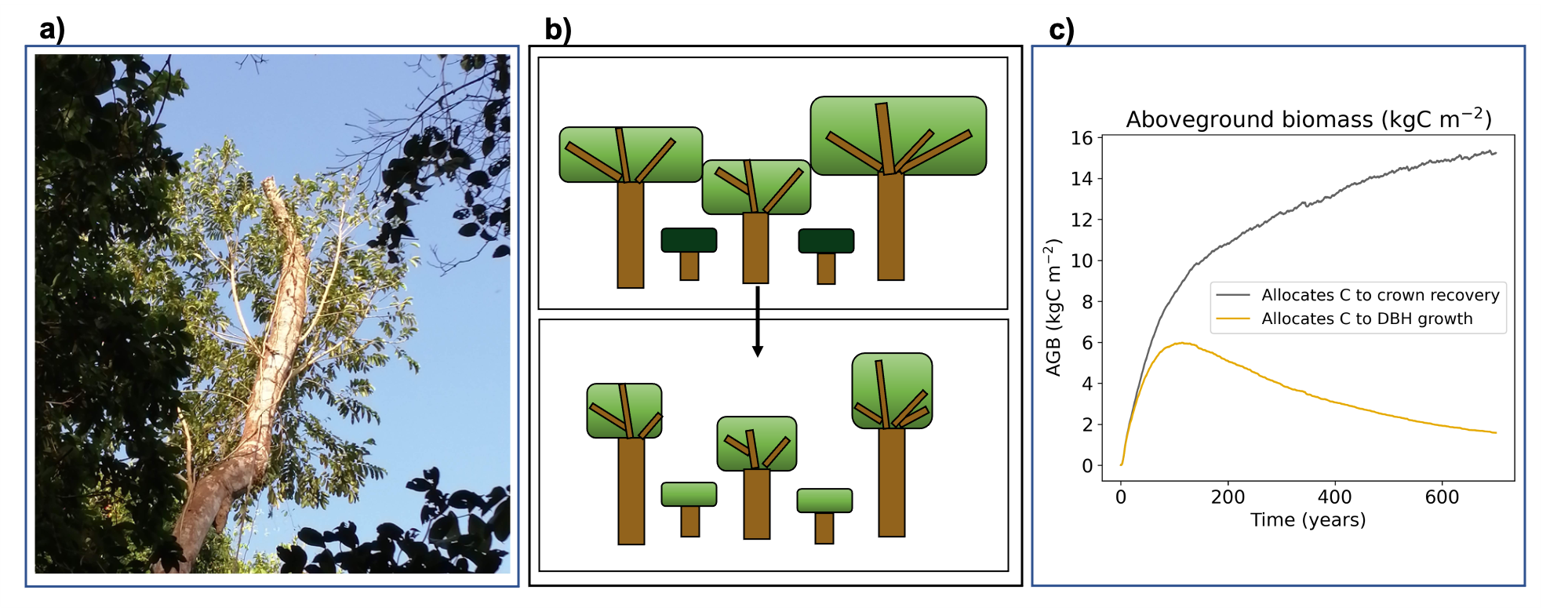June 24, 2022
Tree Crown Damage Alters Canopy Structure and Competitive Dynamics
A novel crown damage module in the FATES model provides new capabilities for testing hypotheses related to disturbance and recovery in tropical forests.

Tree with severe crown damage on Barro Colorado Island (BCI; a). Researchers introduced crown damage into the Functionally Assembled Terrestrial Ecosystem Simulator (FATES) and benchmarked simulations against BCI data (b). Trees allocating carbon to regrowing crowns outcompeted those allocating carbon to diameter growth (c).
[Reprinted with permission from Needham, J.F., et al. "Tree Crown Damage and Its Effects on Forest Carbon Cycling in a Tropical Forest." Global Change Biology 28 5560–74 (2022). DOI:10.1111/gcb.16318. © 2023 John Wiley & Sons Ltd.]
The Science
Forest trees are exposed to a variety of disturbances such as windstorms and lightning. These disturbances can result in significant damage to their crowns, the part of a tree made up of branches and leaves. Little is known about how tree crown damage influences the growth and survival rates of trees or interactions among different tree species. In this study, researchers introduced a way to represent crown damage in a vegetation model. This new capability allows scientists to test how tree crown damage impacts forest dynamics and the carbon cycle.
The Impact
Forests cycle large amounts of water, energy, and carbon with the atmosphere and play an important role in regulating the Earth’s climate. However, forest disturbances that cause crown damage are predicted to become more severe and frequent in the future. Understanding how forests will respond to these disturbances is critical for understanding the long-term role of forests in the biosphere.
Summary
A multi-institutional team of Next-Generation Ecosystem Experiments-Tropics (NGEE-Tropics) researchers introduced a crown damage module into the Functionally Assembled Terrestrial Ecosystem Simulator (FATES), a submodel of the U.S. Department of Energy’s (DOE) Energy Exascale Earth System Model (E3SM). Using this new functionality, scientists were able to test how crown damage alters forest dynamics relative to equivalent increases in tree mortality. Simulated growth and survival rates were benchmarked against data from Barro Colorado Island in Panama. Results revealed that the largest impact of crown damage on aboveground biomass and carbon residence time is due to increases in mortality associated with crown damage. However, simulated crown damage caused changes to forest canopy organization and competitive dynamics between plant functional types. Representing crown damage in vegetation models is important to capture the legacy effects of disturbance and the ways that disturbances that overlap in space or time may interact to increase forest mortality.
Principal Investigator
Jessica Needham
Lawrence Berkeley National Laboratory
jfneedham@lbl.gov
Program Manager
Brian Benscoter
U.S. Department of Energy, Biological and Environmental Research (SC-33)
Environmental System Science
brian.benscoter@science.doe.gov
Funding
This research was supported as part of the Next-Generation Ecosystem Experiments-Tropics (NGEE-Tropics), funded by the Biological and Environmental Research (BER) Program within the U.S. Department of Energy’s (DOE) Office of Science. Support was also received from the DOE Early Career Research Program. Lawrence Berkeley National Laboratory is managed and operated by the Regents of the University of California under prime Contract No. DE-AC02-05CH11231. Barro Colorado Island dendrometer data collection was supported by the HSBC Climate Partnership and Smithsonian Forest Global Earth Observatory.
References
Needham, J.F., et al. "Tree Crown Damage and Its Effects on Forest Carbon Cycling in a Tropical Forest." Global Change Biology 28 (18), 5560–74 (2022). https://doi.org/10.1111/gcb.16318.

